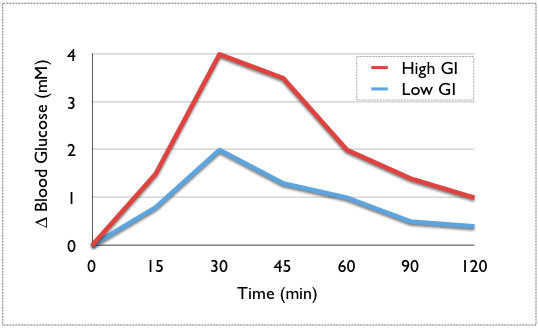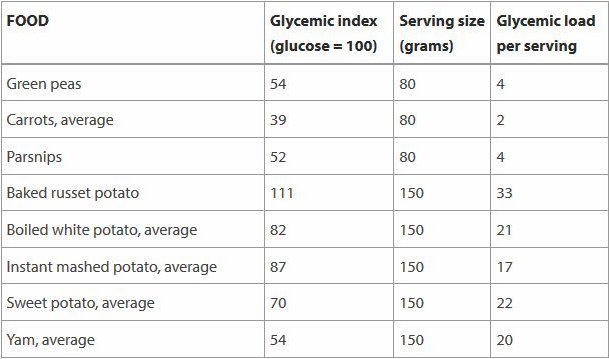
If you are familiar with the “glycemic index,” you may know it as a phrase tossed around by various weight-loss diet plans. But the first scientists who studied the glycemic index of foods did not actually have weight loss in mind.
According to the American Journal of Clinical Nutrition, these scientists wanted to help diabetic patients manage their menus in order to control blood sugar. Later, researchers contended that this kind of diet could also help people manage levels of blood lipids, like the so-called “bad” cholesterol. Only later did the GI get incorporated into the science behind popular diets that could help people lose and/or maintain weight.
What does all this have to do with you and why is it important to your long-term health that you understand the concepts and science that go into the glycemic index? Read on for a full explanation.
How the Glycemic Index Works
The glycemic index really gained attention when nutritionists and doctors began promoting a number of weight-loss and weight-maintenance diets that were based upon the science of the glycemic index. Because this sort of diet only relies on restricting certain kinds of food, it might answer questions about why some people seem to be able to eat a lot of food and stay thin. Perhaps, these people just eat the “right” kind of food and in the proper combinations.

To understand this, it’s important to first understand how the glycemic index works. This summarizes basic information from the Mayo Clinic:
- You shouldn’t think of the glycemic index as a diet but as a tool to help select healthy foods that may help you lose or maintain weight. In this way, you can think of it as similar to calories, carbohydrates, or other measures of food energy.
- The index is based upon the body’s reaction to food. Basically, scientists assign an index value to different foods based on the impact these foods have on blood sugar. If you eat food with a higher value, your blood sugar will rise more and your body will secrete more insulin to store excess energy from that food. High-GI food tends to get stored faster and cause your body to secrete more insulin to move glucose from your blood into storage.
- The glycemic index of food isn’t really set in stone. The way that food gets prepared or even combining foods in different ways can influence the body’s reaction. Also, different people have different metabolisms and may react differently to certain kinds of food. This makes these index-based diets a bit more flexible than some other diets, but it also means it’s important to understand the science so you can customize the approach for your own body and needs.
Low, Medium, and High Glycemic Index Food
Carbohydrates tend to increase the GI of a specific food. Fat and fiber tend to lower it. Protein has no impact upon blood sugar. The index compares how the body reacts to each food when compared to sugar or, in some cases, a slice of white bread. It’s possible to find the GI of a great many foods listed online. For instance, you can use this chart from Harvard that lists a hundred different kinds of food.

Click here to see the full Harvard Medical School chart.
The American Diabetes Association divides food into three basic categories:
- High: An index greater than 70
- Medium: An index between 56 and 69
- Low: An index below 55
For example, non-starchy vegetables and most kinds of fruit have a low glycemic index. Meat doesn’t contain many or any carbs, depending upon preparation, so it should not impact your blood sugar at all. Sweets, processed bread, and Russet potatoes have a high glycemic index.
Food that falls somewhere in the middle include brown rice, whole-grain bread, and quick oatmeal. Oatmeal is a good example that can help you understand how preparation matters. For instance, instant oatmeal has a high glycemic index, steel-cut oatmeal has a low one, and quick oats fall in the middle.
Note: for those of you who have played the Whole Life Challenge, are you starting to see why some of our nutrition “rules” are the way they are?

Wait, What’s That About Potatoes?
While white potatoes have a high GI, sweet potatoes contain more fiber and are considered a fairly low GI selection. Potatoes are just one example of a high-GI food that is usually considered a healthy choice, but may or may not be something you want to eat regularly based on your personal needs and goals.
If you’re interested in losing weight, you might avoid white potatoes for a while. Sweet potatoes have more fiber and can serve as a great substitute. However, if you want to maintain weight or lose weight more slowly, you can still occasionally partake of white potatoes prepared in a healthy way (i.e. baked, not fried).

The nutrient values of different food choices and your personal preferences should matter. After all, the goal of any nutrition plan is to develop healthy eating habits to last a lifetime and not just to lose weight quickly. If you try to restrict all kinds of food forever, you’re likely to fall off your diet. If you understand the particular impact each food has on your body, then you can pick and choose what to eat when and still achieve your performance and body composition goals.
Consider the Overall GI of a Meal
Remember that other kinds of food that you combine with high GI food can reduce your body’s blood sugar response. If you want to enjoy a baked potato, you might eat it with a generous serving of broccoli, some fish, and other low-GI foods to reduce the impact of your overall meal.
Still, your license to enjoy certain high-GI foods responsibly won’t extend to a high-sugar and nutrient-poor food like donuts. That said, if you decide to break your diet and eat a piece of your grandma’s chocolate cake on your birthday, you might also resolve to make up for it by choosing low-GI foods the rest of the day.
If you just crave sweets, try tricking your body with low-GI fruit or add natural stevia or monkfruit sweeteners to your tea. Once you’ve followed your GI-based eating plan for a while, your cravings for unhealthy sweets should start to subside.

How Does the GI Work for Weight Loss and Maintenance?
BioMed Central has reported on studies that clearly demonstrate a GI-based nutrition plan can help people control blood sugar, cholesterol, and other blood indicators related to health. Food researchers seem to agree with the contention that GI can be a useful tool for people who need to control certain health conditions through their food choices.
The studies also seem to support the idea that this kind of nutrition plan can help with weight loss and maintenance in different ways:
- High-GI foods tend to cause blood sugar spikes that signal the body to release more insulin to store energy in the form of fat.
- Low-GI foods get digested more slowly, and this may help curb appetite.
- Many low-GI foods contain a lot of fiber, which further delays and diminishes the body’s absorption of carbohydrates and slows digestion.
How the Glycemic Index Helps You Eat Healthier
Many people have remarked that the glycemic index finally helped them develop healthy eating habits they could stick to. They say that a diet plan based upon this measure of food helps them stick to their diet, feel fuller, and achieve their goals. Nutrition plans based upon the GI don’t require counting calories, avoiding all carbohydrates, weighing food, or even restricting portions of low-GI food.

You might need to eat smaller portions of certain high-GI food, but you can satiate yourself on low-GI food instead. For instance, you’re unlikely to gain weight if you enjoy an extra serving of baked salmon, steamed broccoli, or strawberries. Some high-GI food should be eaten in moderation or avoided when faster weight loss is the goal, but they don’t have to be kept off the table totally.
So yes, some people can eat all sorts of food and still lose weight — they just know the “right” foods to eat. If you’ve struggled with more traditional diets, you might do more research into plans that incorporate GI into menu selection. If you’d like to get some practical experience in this approach to nutrition, consider joining us for the next Whole Life Challenge.



































